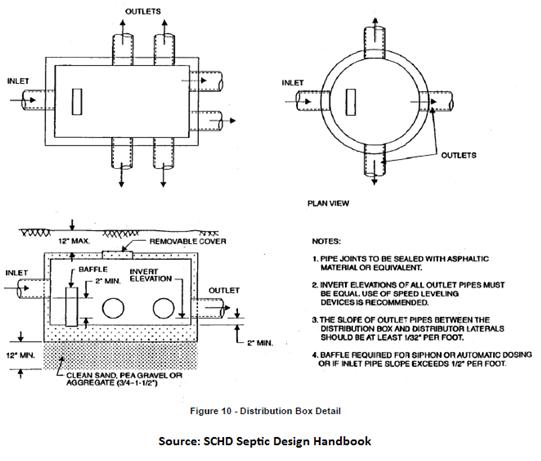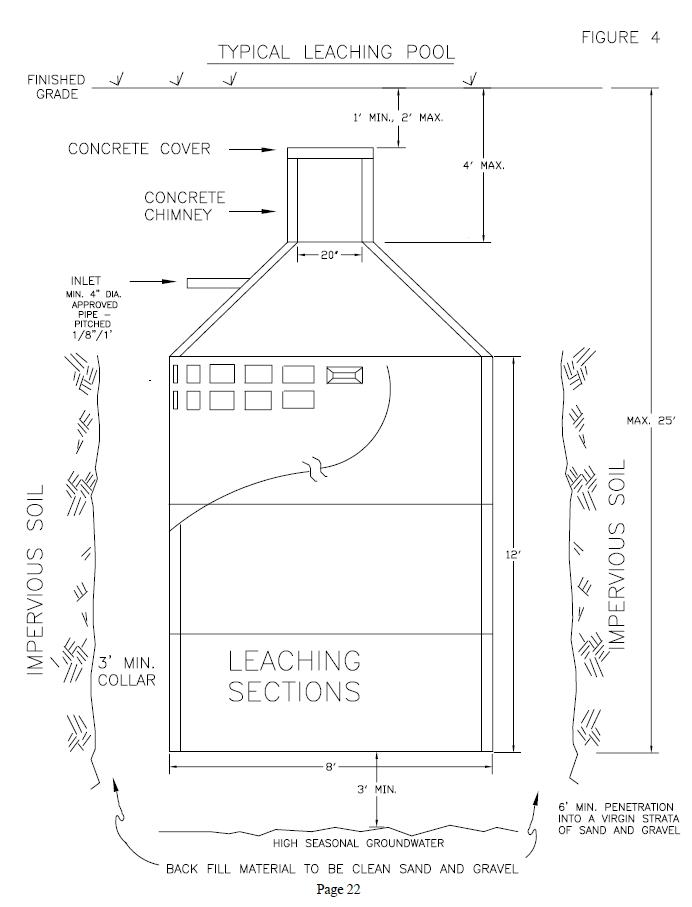Distribution Boxes
A distribution box is an optional piece of equipment that is installed between the outlet pipe of a septic tank and the inlet pipe of a soil absorption system. Distribution boxes are designed to do what the name implies; evenly distribute the outflow of effluent from the septic tank to the absorption system. They are typically used in larger, mostly commercial or agricultural settings, where there is a requirement for more than one soil absorption system. To evenly distribute effluent flow, distribution boxes can range from simple storage boxes with raised pipes, that use a slight downhill gradient, so that gravity can assist with the flow rates, or they can be as complex as to use pressurized systems that allow for short periods of rapid distribution events, with periods of downtime inbetween, as to allow the absorption system to return to an optimal state for the next event.

Soil Absorption Systems
All wastewater, be it directly from the house sewer or from a septic tank, is discharged to a subsurface treatment system, or absorption system. Absorption systems are designed to filter and oxidize most dissolved chemicals and suspended solids left in the effluent from the septic tank by the use of biodegradation and hydrodynamic processes. The most common types of treatment systems are absorption fields, cesspools and seepage pits. Prior to installation, the contractor would have performed a soil investigation to best determine which type of system to install. In Suffolk County, the most widely used form of subsurface treatment system is a cesspool or seepage pit, which is commonly used in conjunction with a septic tank. Absorption fields and beds are much less common due to the soil type and available plot sizes found throughout the county.
Cesspools
Cesspools were the most common form of household waste disposal before the advent of the septic tank system. They are basically the predecessor to today’s septic system and were built mainly for convenience and ease of construction. A cesspool is much like a seepage pit - basically a cylindrical pit dug into the ground, with porous inner walls built of masonry, stone or concrete rings, and an outer wall comprised of an aggregate such as gravel. The pit is then covered with a concrete lid and back filled with soil. Cesspools, in conjunction with a septic system, are the most widely used form of subsurface absorption systems throughout Suffolk County.
Cesspools today are constructed of precast concrete rings that are normally about 4 to 6 feet in diameter and a few feet deep, although the sizes may change depending on the number of people they will need to accommodate. An inlet pipe allows effluent to flow into the inner chamber, where it is retained. Any sludge particles left in the effluent that manages to make it past the septic tanks’s outflow baffle, if one is installed, settles on the bottom of the cesspool. The liquid portion that settles on top of the sludge layer is allowed to slowly disperse through perforations in the concrete and into the surrounding soil. In the substrate immediately adjacent to the cesspool, anaerobic bacteria convert dissolved nitrite in the liquid effluent into a form of nitrogen called ammonium. The effluent plume surrounding the cesspool, containing ammonium and other contaminants, flow away from the saturated soil substrate through hydrodynamic processes such as dispersion, diffusion and advection. If the plume is able to travel far enough away to reach mostly unsaturated soils, aerobic bacteria take over and can begin to convert the ammonium into nitrate. The nitrification of ammonium in the soils surrounding cesspools has been determined to be the primary source of nitrate contamination in the groundwater that supplies high density residential areas.

Groundwater Contamination is becoming a huge topic of interest on Long Island and has been continually studied for decades. Trying to determine the causes and find solutions to minimize its effects are extremely important. One cause that has been increasingly studied for the past decade is contamination by Failing Septic Systems.